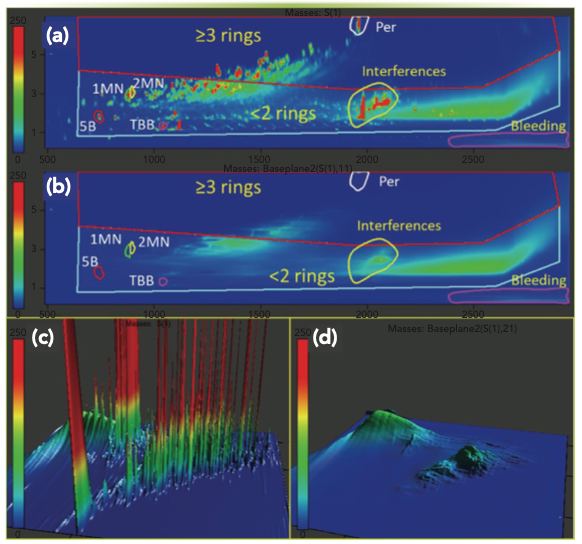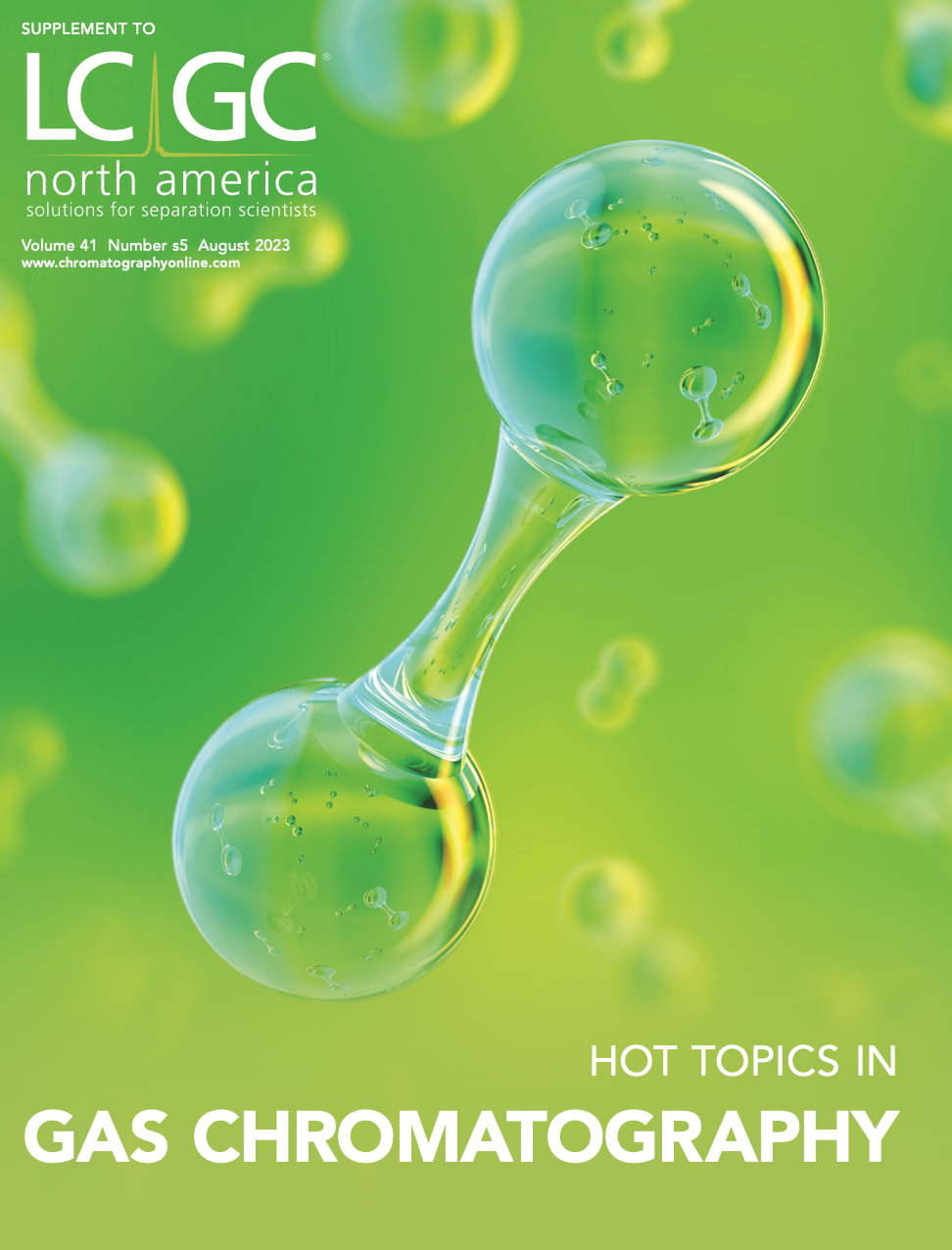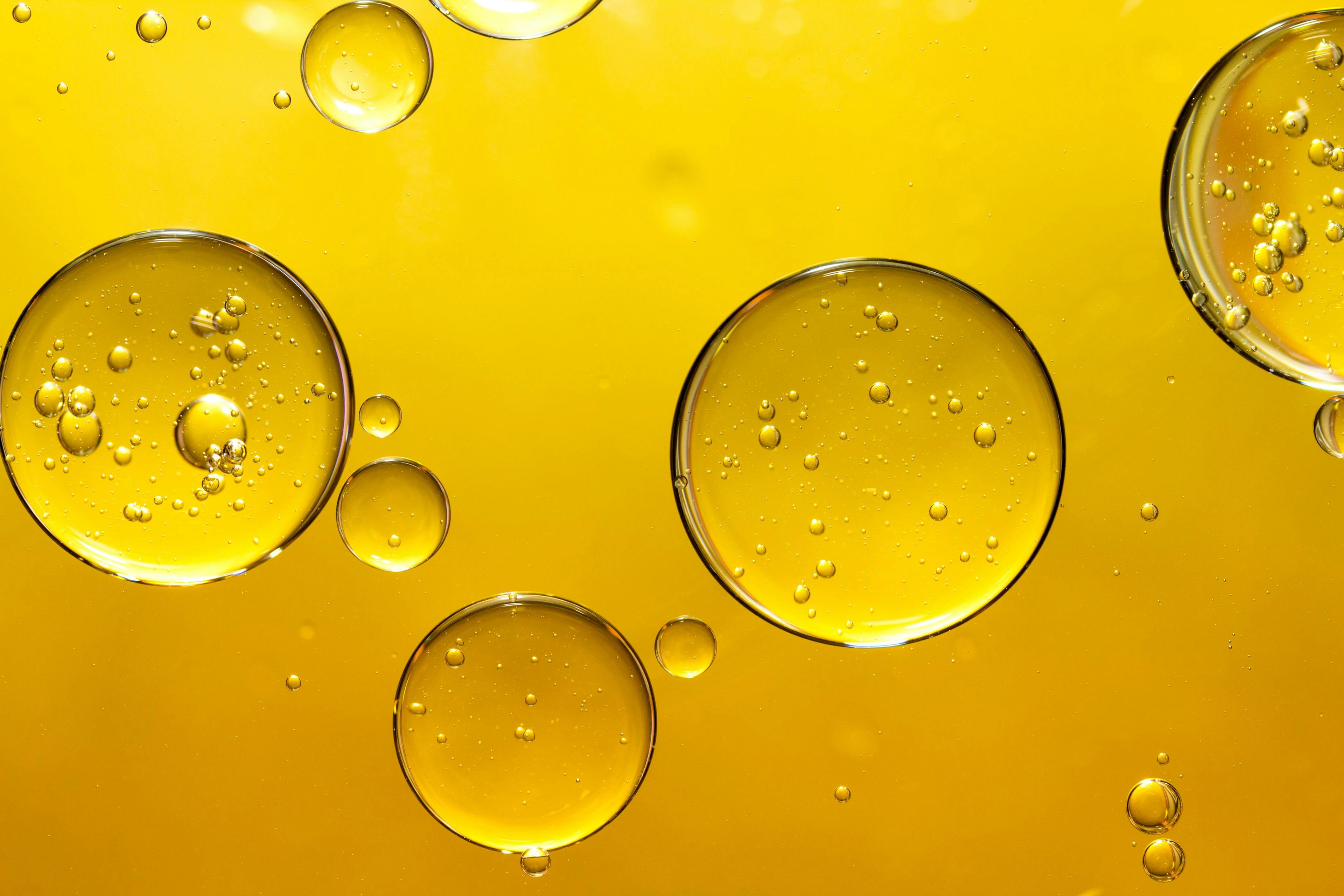Towards the Use of Multidimensional Gas Chromatography Techniques in Routine Analysis: The Mineral Oil Case
Since their first introduction, multidimensional hyphenated gas chromatographic techniques have become invaluable tools in understanding the complexity of a wide range of samples. Nevertheless, their diffusion into routine laboratories has faced resistance due to common perceptions that they are challenging to implement and lack sufficient robustness. This paper steers readers through the role of hyphenated techniques in the field of mineral oil analysis in food and highlights their essential role in routine analysis.
The introduction of gas chromatography (GC) dates back to 1952 (1). Shortly after, in 1958, the power of the technique was boosted by the introduction of the capillary column (2), increasing the peak capacity by roughly an order of magnitude compared to the initial packed columns. Nevertheless, scientists continued to explore ways to expand the separation capabilities, and, in 1980 and 1991, two other groundbreaking advancements in GC techniques were introduced.
In 1980, the first attempt to hyphenate liquid chromatography (LC) and GC was presented (3). However, it was not until 1984 that the technique was upgraded to accommodate the transfer of large solvent volume (4). Since then, the technique has followed a winding path, never gaining the attention it deserved, and even facing commercial discontinuation until 2008. It was the application for mineral oil hydrocarbons (MOH) analysis that revitalized the technique, steering it among the established routine techniques (5–7).
In 1991, bidimensional comprehensive GC (GC×GC) was introduced for the first time (8). Unlike LC–GC, it quickly garnered attention, and spread across various research fields (9,10). Despite its popularity in research and its undeniable benefits, the technique has not found the routine application it merits.
The resistance to accepting multidimensional techniques on a routine basis primarily stems from concerns regarding the initial investment cost and the perception of it being a complex technique. Moreover, as the result interpretation is not always straightforward, the technique itself is often perceived as neither robust nor reliable. As a result, analysts in the quality control sector require highly intricate applications to be convinced of utilizing multidimensional gas chromatographic techniques. In this regard, the challenges posed by MOH analysis in food fully justify the use of these techniques.
Mineral Oil Hydrocarbons in Food: Setting the Frame of the Analytical Challenge
MOH primarily consists of linear and branched paraffins, alkyl-substituted cycloalkanes, and alkyl-substituted (poly)aromatic hydrocarbons, with varying numbers of fused rings (11). Traditionally, these compounds are divided into two categories: mineral oil aromatic hydrocarbons (MOAH), encompassing all aromatic compounds, and mineral oil saturated hydrocarbons (MOSH), which include the remaining compounds.
The presence of MOH in food has been known since the 1990s (12). However, it was only in 2008 and 2009 that institutions and public opinion started paying attention, following the discovery of highly contaminated sunflower oil from Ukraine and the migration of a high amount of MOH from recycled paper packaging (13,14). In 2012, the European Food Safety Authority (EFSA) expressed its opinion, stressing the lack of toxicological information, occurrence data, and the need for improved approaches to address the analytical challenge (15). In 2019, a new EFSA opinion stressed the necessity to accurately quantify the MOAH with three or more rings due to their higher toxicological concern (16). Recently, the drafts of a new EFSA opinion has been released, but with no substantial advancement compared to the previous ones (https://connect.efsa.europa.eu/RM/s/publicconsultation2/a0l09000006qqHf/pc0400).
The overall uncertainty surrounding risk assessment and the lack of robustness in analytical methods had hindered the establishment of a legal limit until April 2022. However, under public pressure, the Standing Committee on Plants, Animals, Food and Feed Section (SCoPAFF) set a “de facto” maximum acceptable limits solely for MOAH. These limits correspond to the limits of quantification (LOQs) reported in the Guidance published by the Joint Research Center (JRC)—0.5 mg/kg for dry food (≤4% fat/oil), 1 mg/kg for foods with high fat/oil content (>4% , ≤50% fat/oil), and 2 mg/kg for fats/oils or foods with >50% fat/oil (17,18).
It is the authors’ opinion that a limit only on the MOAH may be misleading, as it could lead to disregarding the MOSH fraction and focusing only on analyzing MOAH. Such an approach would fail to provide the information for the first plausibility check highlighted in the JRC Guidance regarding the ratio between MOSH and MOAH (17,18).
Mineral Oil Hydrocarbons in Food: The Analytical Challenge Towards Multidimensional Solutions
The analytical determination and characterization of MOH has always been tightly related to the use of multidimensional chromatographic techniques (7). Overall, the detailed qualitative and quantitative characterization of MOH into MOSH and MOAH, along with their respective subclasses, is a complex undertaking at every stage of the analytical process. This complexity encompasses the extraction and purification steps, chromatographic separation, and the necessity of a meticulous interpretation of the chromatogram, which requires proper training, to accurately integrate and quantify MOSH and MOAH. Details regarding the sample preparation steps are provided elsewhere (7,19–24); here, the focus is on the role of chromatographic separation and multidimensional GC to support the final data interpretation.
As mentioned earlier, the routine method for MOSH and MOAH separation and quantification is based on the LC–GC-flame ionization detection (FID) method presented in 2009 (11). The method uses a silica LC column to separate the MOSH fraction, which is eluted practically without retention, followed by the MOAH fraction. The triglycerides, on the other hand, are retained in the column, and are subsequently eliminated by backflushing the column with dichloromethane. The MOSH and MOAH fractions are transferred online to the GC column through using an on-column interface and exploiting the partially concurrent eluent evaporation technique. Specific internal standards are used to control the efficient transfer of the fraction of interest and perform the quantification of the MOSH and MOAH hump at the FID (20).
Despite the routine use of the sophisticated, hyphenated, and thoughtfully designed method, limitations remain in interpreting the final chromatogram. Specifically, the removal of the riding peaks and possible superimposed hump is a complex task that necessitates highly trained operators, and even then, a high level of uncertainty remains. To address this critical aspect, the JRC has published a report that provides guidance on the correct integration and interpretation of results (25). Additionally, other literature resources, such as (19), are available. The routine LC–GC-FID method has some notable limitations, including: i) the inability to confirm the identity of the observed hump, and ii) the lack of additional information regarding the subclasses of MOAH, which is required by the EFSA for a more accurate risk assessment. Regarding the latter, the EFSA document published in 2019 (16) clearly states in the recommendations that the characterization of the 3–7 rings MOAH should be routinely performed whenever MOAH are detected in food.
At present, the most efficient solution to these gaps is GC×GC. Indeed, the use of donor-acceptor complex chromatography LC to separate mono- and diaromatic MOAH from the polyaromatic ones was proposed but never further validated (26); on the other side, the use of a MS detector for confirmation does not provide significantly selective information, thusly not reducing the uncertainty (27). On the contrary, the chemical patterns provided by the GC×GC separation unequivocally support the characterization and interpretation of the hump (27–28).
In recent years, GC×GC has become a routine technique for confirming the identity of the hump observed in chromatograms. However, it is only recently that further technological advancements have enabled the use of GC×GC chromatograms for reliable quantification of MOSH and MOAH, facilitating a comprehensive sub-classes characterization. This advancement allows for robust quantification of both 1–2 rings and 3+ rings MOAH, which is essential for toxicological evaluation (29–32). Furthermore, the routine use of GC×GC helps in reducing additional uncertainties related to the baseline positioning in LC–GC-FID chromatograms, as highlighted by the JRC (25). In GC×GC, bleeding is chromatographically separated from the MOSH and MOAH fractions. Moreover, it helps the removal of riding peaks and supports overall plot interpretation using both the 2D and 3D visualization (Figure 1) (24).
FIGURE 1: MOAH fraction of coconut oil analyzed by LC–GC×GC-FID. (a) Two-dimensional (2D) plot highlighting the relevant separation between 2 (and 2.5 rings) and the 3 or more rings. (b) Visualization of the 2D plot after removal of the riding peaks. The same chromatograms are visualized in 3D (c) before and (d) after riding peaks removal.

The proof of the ability to quantify the MOSH and MOAH in GC×GC has been mainly reported using a rather complex LC-2(GC×GC)-FID/time-of-flight mass spectrometry (TOF-MS) platform, which has led to the erroneous perception that to use GC×GC on a routine basis, the complete LC-2(GC×GC)-FID/TOF-MS system is needed. Certainly, utilizing the complete platform offers the advantages of any automated technique, such as reducing manipulations that may lead to sample losses and contamination. Nevertheless, an offline system can be used as well. The critical aspect lies in the GC×GC inlet, which must have no discrimination in the volatility range of interest (C10–C50). This requirement implicitly calls for an on-column inlet and a large volume injection to reach the required sensitivity. Therefore, quantification can be routinely performed in any GC×GC-FID system, provided that the correct injection technique is installed.
The use of GC×GC–MS remains important for additional confirmation purposes and the detection of markers. In this case, discrimination is not a problem as long as it does not hinder the detection of the high boiling compounds of interest.
In conclusion, routine laboratories do not need to make expensive investments since most are already equipped with an LC–GC-FID for routine purposes and a GC×GC–MS for confirmation. By upgrading the existing LC–GC-FID system to GC×GC, laboratories can enhance their already advanced and multidimensional routine method, providing highly informative results and answering the EFSA requirements by exploiting an additional dimension.
Acknowledgments
This work is supported by Fonds de la Recherche Scientifique Belgique (FNRS) (PDR projects-ToxAnaMOH, T.0187.23).
Conflict of Interest
The authors have no financial or proprietary interests in any material discussed in this article.
The authors have no relevant non-financial interests to disclose.
References
(1) James, A. T.; Martin, A. J. P. Gas-Liquid Partition Chromatography; the Separation and Micro-estimation of Volatile Fatty Acids from Formic Acid to Dodecanoic Acid. Biochem. J. 1952, 50, 679–690. DOI: 10.1042/bj0500679
(2) Golay, M. J. E. Gas Chromatography; Desty, D. H., Ed.; Butterworth; 1958; p 36.
(3) Majors, R. E. Multidimensional High Performance Liquid Chromatography. J. Chromatogr. Sci. 1980, 18 (10), 571–579. DOI: 10.1093/chromsci/18.10.571
(4) Grob, K.; Fröhlich, D.; Schilling, B.; Neukom, H. P.; Nägeli, P. Coupling of High-Performance Liquid Chromatography with Capillary Gas Chromatography. J. Chromatogr. A 1984, 295, 55–61. DOI: 10.1016/S0021-9673(01)87597-X
(5) Purcaro, G.; Moret, S.; Conte, L. Hyphenated Liquid Chromatography–Gas Chromatography Technique: Recent Evolution and Applications. J. Chromatogr. A 2012, 1255, 100–111. DOI: 10.1016/j.chroma.2012.02.018
(6) Purcaro, G.; Moret, S.; Conte, L. Sample Pre-fractionation of Environmental and Food Samples using LC-GC Multidimensional Techniques. Trends Analyt. Chem. 2013, 43, 146–160. DOI: 10.1016/j.trac.2012.10.007
(7) Sdrigotti, N.; Collard, M.; Purcaro, G. Evolution of Hyphenated Techniques for Mineral Oil Analysis in Food. J. Sep. Sci. 2021, 44, 464–482. DOI: 10.1002/jssc.202000901
(8) Liu, Z.; Phillips, J. B. Comprehensive Two-Dimensional Gas Chromatography using an On-Column Thermal Modulator Interface. J. Chromatogr. Sci. 1991, 29 (6), 227–231. DOI: 10.1093/chromsci/29.6.227
(9) Tranchida, P. Q.; Purcaro, G.; Dugo, P.; Mondello, L.; Purcaro, G. Modulators for Comprehensive Two-Dimensional Gas Chromatography. Trends Analyt. Chem. 2011, 30 (9), 1437–1461. DOI: 10.1016/j.trac.2011.06.010
(10) Tranchida, P. Q.; Purcaro, G.; Maimone, M.; Mondello, L. Impact of Comprehensive Two-Dimensional Gas Chromatography with Mass Spectrometry on Food Analysis. J. Sep. Sci. 2016, 39 (1), 149–161. DOI: 10.1002/jssc.201500379
(11) Biedermann, M.; Fiselier, K.; Grob, K. Aromatic Hydrocarbons of Mineral Oil Origin in Foods: Method for Determining the Total Concentration and First Results. J. Agric. Food Chem. 2009, 57 (19), 8711–8721. DOI: 10.1021/jf901375e
(12) Grob, K.; Artho, A.; Biedermann, M.; Egli, J. Food Contamination by Hydrocarbons from Lubricating Oils and Release Agents: Determination by Coupled LC‐GC. Food Addit. Contam. 1991, 8 (4), 437–446. DOI: 10.1080/02652039109373993
(13) Grob, K. Could the Ukrainian Sunflower Oil Contaminated with Mineral Oil Wake Up Sleeping Dogs? Eur. J. Lipid Sci. Technol. 2008, 110 (11), 979–981. DOI: 10.1002/ejlt.200800234
(14) Biedermann, M.; Grob, K. Is Recycled Newspaper Suitable for Food Contact Materials? Technical Grade Mineral Oils from Printing Inks. Eur. Food Res. Technol. 2010, 230 (5), 785–796. DOI: 10.1007/s00217-010-1223-9
(15) European Food Safety Authority (EFSA). Scientific Opinion on Mineral Oil Hydrocarbons in Food. EFSA J. 2012, 10 (6), 2704. DOI: 10.2903/j.efsa.2012.2704
(16) European Food Safety Authority (EFSA); Arcella, D.; Baert, K.; Binaglia, M. Rapid Risk Assessment on the Possible Risk for Public Health Due to the Contamination of Infant Formula and Follow-On Formula by Mineral Oil Aromatic Hydrocarbons (MOAH). EFSA Support. Publ. 2019, 16 (11). DOI: 10.2903/sp.efsa.2019.EN-1741
(17) Bratinova, S.; Hoekstra, E. Guidance on Sampling, Analysis and Data Reporting for the Monitoring of Mineral Oil Hydrocarbons in Food and Food Contact Materials. EUR 29666 EN; Publications Office of the European Union: Luxembourg, 2019, DOI: 10.2760/208879
(18) Bratinova, S.; Robouch, P.; Hoekestra, E. Guidance on Sampling, Analysis and Data Reporting for the Monitoring of Mineral Oil Hydrocarbons in Food and Food Contact Materials, 2nd ed.; Publications Office of the European Union: Luxembourg, 2023. DOI: 10.2760/963728
(19) Biedermann, M.; Grob, K. On-line Coupled High Performance Liquid Chromatography-Gas Chromatography for the Analysis of Contamination by Mineral Oil. Part 1: Method of Analysis. J. Chromatogr. A 2012, 1255, 56–75. DOI: 10.1016/j.chroma.2012.05.095
(20) Biedermann, M.; Grob, K. On-line Coupled High Performance Liquid Chromatography-Gas Chromatography for the Analysis of Contamination by Mineral Oil. Part 2: Migration from Paperboard into Dry Foods: Interpretation of Chromatograms. J. Chromatogr. A 2012, 1255, 76–99. DOI: 10.1016/j.chroma.2012.05.096
(21) Weber, S.; Schrag, K.; Mildau, G.; Kuballa, T.; Walch, S. G.; Lachenmeier, D. W. Analytical Methods for the Determination of Mineral Oil Saturated Hydrocarbons (MOSH) and Mineral Oil Aromatic Hydrocarbons (MOAH)—A Short Review. Anal. Chem. Insights 2018, 13, 1–16. DOI: 10.1177/1177390118777757
(22) Purcaro, G.; Barp, L.; Moret, S. Determination of Hydrocarbon Contamination in Foods. A Review. Anal. Methods 2016, 8 (29), 5755–5772. DOI: 10.1039/C6AY00655H
(23) Polyakova, A.; van Leeuwen, S.; Peters, R. Review on Chromatographic and Specific Detection Methodologies for Unravelling the Complexity of MOAH in Foods. Anal. Chim. Acta 2022, 1234, 340098. DOI: 10.1016/j.aca.2022.340098
(24) Bauwens, G.; Gorska, A.; Purcaro, G. The Role of Comprehensive Two-Dimensional Gas Chromatography in Mineral Oil Determination. Anal. Bioanal. Chem. 2023. DOI: 10.1007/s00216-023-04718-3
(25) Robouch, P.; Bratinova, S.; Goncalves, C.; Karasek, L.; Beldi, G.; Senaldi, C.; Valzacchi, S.; Hoekstra E. Mineral Oil in Infant Formulas - Guidelines for Integrating Chromatogram; JRC IF 2022-04 - a Virtual Interlaboratory Comparison, EUR 31101 EN; Publications Office of the European Union: Luxembourg, 2022. DOI: 10.2760/904003
(26) Koch, M.; Becker, E.; Päch, M.; Kühn, S.; Kirchhoff, E. Separation of the Mineral Oil Aromatic Hydrocarbons of Three and More Aromatic Rings from Those of One or Two Aromatic Rings. J. Sep. Sci. 2020, 43 (6), 1089–1099. DOI: 10.1002/jssc.201900833
(27) Biedermann, M.; McCombie, G.; Grob, K.; Kappenstein, O.; Hutzler, C.; Pfaff, K.; Luch A. FID or MS for Mineral Oil Analysis? J. Verbrauch. Lebensm. 2017, 12 (4), 363–365. DOI: 10.1007/s00003-017-1127-8
(28) Bratinova, S.; Hoekstra, E.; Emons, H.; Hutzler, C.; Kappenstein, O.; Biedermann, M.; McCombie, G. The Reliability of MOSH/MOAH Data: A Comment on a Recently Published Article. J. Verbrauch. Lebensm. 2020, 15, 285–287. DOI: 10.1007/s00003-020-01287-w
(29) Bauwens, G.; Barp, L.; Purcaro, G. Validation of the Liquid Chromatography-Comprehensive Multidimensional Gas Chromatography-Time-of-Flight Mass Spectrometer/ Flame Ionization Detector Platform for Mineral Oil Analysis Exploiting Interlaboratory Comparison Data. Green Anal. Chem. 2023, 4, 100047. DOI: 10.1016/j.greeac.2022.100047
(30) Bauwens, G.; Cavaco Soares, A.; Lacoste, F.; Ribera D.; Blomsma, C.; Berg, I.; Campos, F.; Coenradie, A.; Creanga, A.; Zwagerman, R.; Purcaro, G. Investigation of the Effect of Refining on the Presence of Targeted Mineral Oil Aromatic Hydrocarbons in Coconut Oil. Food Addit. Contam. Part A Chem. Anal. Control Expo. Risk Assess. 2023, 40 (3), 392–403. DOI: 10.1080/19440049.2022.2164621
(31) Bauwens, G.; Pantó, S.; Purcaro, G. Mineral Oil Saturated and Aromatic Hydrocarbons Quantification: Mono- and Two-Dimensional Approaches. J. Chromatogr. A 2021, 1643, 462044. DOI: 10.1016/j.chroma.2021.462044
(32) Biedermann, M.; Eicher, A.; Altherr, T.; McCombie, G. Quantification of Mineral Oil Aromatic Hydrocarbons by Number of Aromatic Rings via Comprehensive Two-Dimensional Gas Chromatography: First Results in Food. J. Chromatogr. Open 2022, 2, 100072. DOI: 10.1016/j.jcoa.2022.100072
Grégory Bauwens, Aleksandra Gorska, and Giorgia Purcaro are with the Analytical Chemistry Laboratory of Gembloux Agro-Bio Tech, at the University of Liège, in Gembloux, Belgium. Direct correspondence to: gpurcaro@uliege.be

Analysis of Pesticides in Foods Using GC–MS/MS: An Interview with José Fernando Huertas-Pérez
December 16th 2024In this LCGC International interview with José Fernando Huertas-Pérez who is a specialist in chemical contaminants analytics and mitigation at the Nestlé Institute for Food Safety and Analytical Sciences at Nestlé Research in Switzerland, In this interview we discuss his recent research work published in Food Chemistry on the subject of a method for quantifying multi-residue pesticides in food matrices using gas chromatography–tandem mass spectrometry (GC–MS/MS) (1).
The Use of SPME and GC×GC in Food Analysis: An Interview with Giorgia Purcaro
December 16th 2024LCGC International sat down with Giorgia Purcaro of the University of Liege to discuss the impact that solid-phase microextraction (SPME) and comprehensive multidimensional gas chromatography (GC×GC) is having on food analysis.







